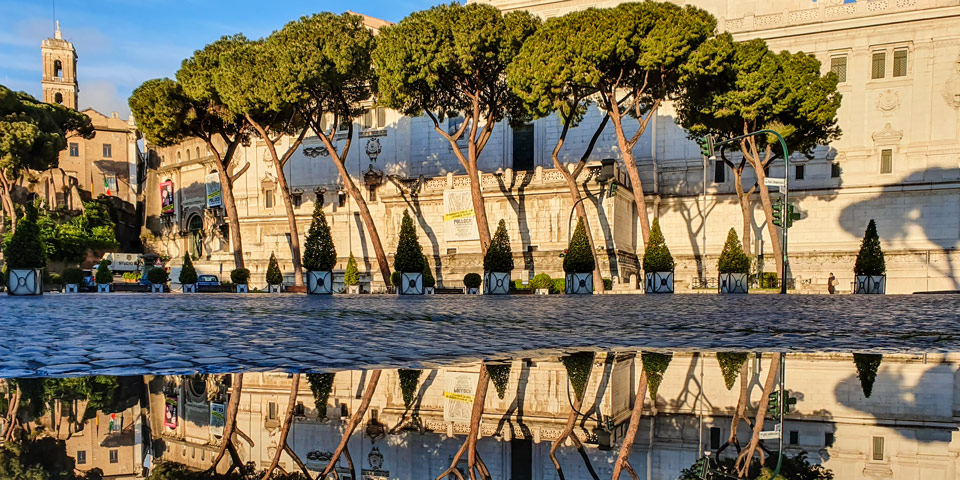

24786 views
Written by: Artur Jakucewicz

Anyone who has ever strolled through the streets of Rome is bound to remember one peculiar yet majestic aspect of the city: the Umbrella Pine Trees.
These towering trees, scientifically known as Pinus Pinea, are more than just a part of Rome’s skyline; they are symbols of the Eternal City itself. With their whimsical shapes, they have been compared to illustrations straight out of a Dr. Seuss book. Some tourists even lovingly refer to them as nature’s version of broccoli due to their tall, slender trunks and expansive, broccoli-like canopies.
These distinctive trees, resembling umbrellas or parasols high in the air, contribute to the city’s aesthetic charm to its lush landscape. Their unforgettable profiles are an integral part of what makes Rome unforgettable.
Contents
ToggleHistorically, the Umbrella Pine Trees have deep roots in Mediterranean culture, initially brought to Italy by Greek settlers. These trees were revered in ancient times, symbolizing various deities like Cybele and Neptune.
Later, their importance shifted towards practical uses, notably in shipbuilding and winemaking. In the 20th century, Mussolini brought a dramatic change, lining Rome’s avenues, such as Via Appia Antica (the Appian Way) and Via Dei Fiori Imperali, with these majestic pines.
This initiative transformed Rome’s landscape and ingrained the trees in the city’s identity. Consequently, these trees have become more than natural wonders; they are symbols of Rome’s historical and cultural evolution.
The Umbrella Pine, or Pinus Pinea, boasts a distinctive appearance that captures the imagination. Initially, in its youth, the tree presents as a bushy globe.
As it matures, this globe transforms into an iconic umbrella-shaped canopy perched atop a slender trunk. This unique canopy spreads wide, reaching approximately 26 feet (about 8 meters). The average height of these trees ranges from 40 to 60 feet (about 12 to 18 meters), although some specimens tower impressively up to 80 feet (approximately 24 meters).
The bark of the Umbrella Pine is noteworthy, too, characterized by its thick, deeply fissured texture and a rich, red-brown hue, adding a rugged charm to its stately elegance.
Originally native to the Mediterranean, the Umbrella Pine has found a special place in the heart of Rome. Despite their widespread presence across the Mediterranean basin, it’s in Rome where they have become symbolic.
Additionally, these trees have adapted well to various environments, thriving along coastlines and in urban settings. Their adaptability and resilience have allowed them to become an integral part of not just Rome’s but also the broader Mediterranean’s ecological and cultural landscape.
The Umbrella Pine, or Pinus Pinea, has long been valued for more than its striking appearance. Historically, these trees have been integral to various aspects of Mediterranean life. Their seeds, known as pine nuts or ‘pignoli,’ are cherished in ancient and modern Roman cuisine, adding a unique flavor to dishes like pesto.
Beyond culinary uses, the wood of the Umbrella Pine played a crucial role in shipbuilding in ancient times. In modern contexts, these trees are predominantly appreciated for their ornamental value, enhancing the aesthetic beauty of parks, gardens, and cityscapes.
Moreover, the Umbrella Pine is not just a decoration; it contributes significantly to the ecological health of its surroundings, providing habitat for diverse wildlife and aiding in soil conservation.
While the Umbrella Pine is a resilient species, it faces several conservation challenges. A notable concern is their lifespan, ranging from 50 to 150 years.
Many of the trees in Rome, particularly those planted during Mussolini’s era in the late 1920s, are approaching the end of their natural lives. This aging population poses maintenance challenges, as older trees are more susceptible to damage from weather, pests, and diseases. Among the threats, the western conifer seed bug and the fungal pathogen Pestalotiopsis pini have emerged as significant concerns, affecting both the health of the trees and the pine nut crop.
The city of Rome thus faces the daunting task of preserving these iconic trees, ensuring they continue to grace the cityscape without posing risks to public safety and infrastructure. This endeavor is about maintaining a species and keeping a living symbol of Rome’s heritage and natural beauty.
Today, the Umbrella Pines of Rome (Roma) are natural wonders and integral parts of the city’s urban fabric. These majestic trees, with their characteristic canopy, are prominently featured in several key locations, each offering a unique perspective of their beauty and Rome’s historical landscape. In Piazza Venezia, they stand as verdant sentinels, framing views of the bustling square and its surrounding architecture. The lush gardens of Villa Borghese are another prime location where these pines add to the serene and artistic atmosphere, creating a picturesque setting that has inspired countless artists and poets.
Moving to Villa Pamphili, Rome’s largest public park, the Umbrella Pines contribute significantly to the park’s charm, offering shaded paths and scenic spots for relaxation and leisure.
The trees are also a splendid sight from the observation decks on the Aventine and Gianicolo hills, where they punctuate the skyline and provide breathtaking city views. These locations showcase the Umbrella Pines’ aesthetic appeal and their role in enhancing Rome’s cultural and historical richness.
The Umbrella Pine Trees, or Pinus Pinea, are more than just a species of tree in Rome; they are a symbol of the city’s history, culture, and natural beauty. From their ancient Mediterranean origins to their significant role in contemporary Rome, these trees have witnessed and withstood the test of time. As they grow and spread their wide canopies over the Eternal City, they remind us of Rome’s perpetual resilience and charm. Ensuring their preservation is not just an ecological imperative but a tribute to the city’s heritage, ensuring that future generations can experience the same sense of wonder and connection to history these majestic trees provide.
Author: Artur Jakucewicz
This website uses cookies. For more info read the cookies policy
Rome.us © 2025. Created with love by Roman experts and guides.